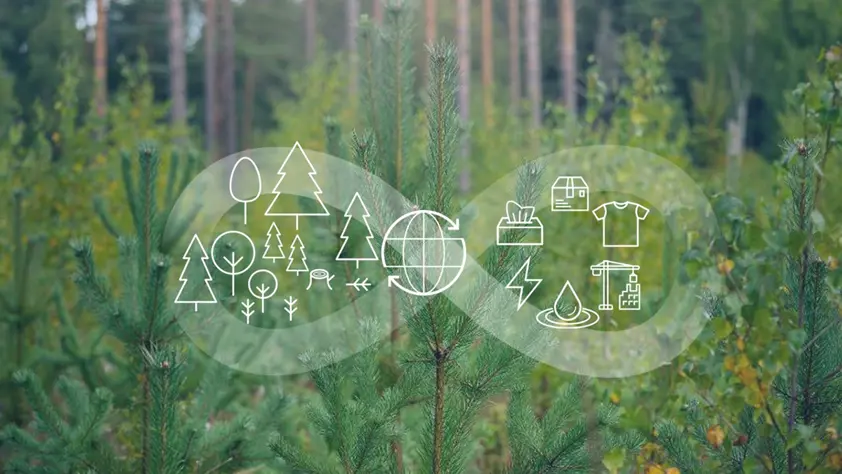The world will have 2 billion new middle-class consumers by 2030, which inevitably means consumption levels will increase. As a result, the world is seized by the problem of balancing rising demand for raw materials, with a finite supply. So what could be the solution? Circular economies might hold the answer.
A circular economy is a system aimed at maximising the use of resources and reducing waste by making the best possible use of a product. Unlike the traditional ‘take and make’, a circular economy thrives on a ‘Reuse and Recycle’ model. For the pulp and paper industry, this model hits close to home.
“Paper has always been recycled,” says Jori Ringman, Deputy Director General at the Confederation of European Paper Industries (CEPI), a non-profit-making organisation, based in Brussels. “The first paper in medieval times came from recycled textiles,” he explains. When the demand for paper grew in the 19th century, and there wasn’t enough recycled textile available, cellulose fibre was introduced.
Reuse and recycle
The circular economy approach continues to serve the industry well even in modern times.
“Recycling graphic paper, like newspapers and magazines, on a large, organised scale started in the 60s,” says Thomas Krauthauf, Vice President RCP & CEWS at UPM Communication Papers. Paper companies started to buy their paper back from the local authorities, ensuring that recyclable material is always available. In fact, recycling in the industry has increased by 49% since 1998 to reach 19.5 million tonnes.
In 2017, 72.3% of all paper consumed in Europe was recycled, according to the European Paper Recycling Council. The signatories of the new European Declaration on Paper Recycling have committed to reaching a 74% paper recycling rate by 2020. But there are some barriers to reaching that goal.
“Unfortunately, in some regions, especially in Eastern Europe, the level of collection is low,” says Krauthauf. Both UPM and CEPI are advocating measures to reverse this. “However, if someone puts a newspaper in the general waste bin, we can’t get it back.” Tissue-based products such as toilet paper, diapers and paper tissues usually cannot be recycled.
“Everybody has a responsibility to recycle,” says Krauthauf, who is also Chairman of the International Association of the Deinking Industry (INGEDE). “We work closely together with the suppliers of ink, glue and machines to make sure we can reuse the paper.”
Pushing past the limits
Some of the final products cannot be recycled currently on a large scale, says Krauthauf. However, producers like the label material supplier UPM Raflatac, for example, recently developed a new type of glue for labels that can now easily be separated from the paper during the recycling process
Paper can’t be recycled forever though. After 20 to 25 times, wood fibres are worn out. “When you wear your favourite t-shirt for years, it will also get holes,” explains Ringman. “Natural fibres used for paper have the same characteristics.”
In practice, paper can only be recycled five to seven times, because, besides the fact that not all paper is returned to the paper producers, part of the fibres get lost during the recovery, collection and sorting process. “This means you cannot collect enough from yesterday’s consumption for tomorrow’s growing needs,” says Ringman. “This is true for all materials in the circular economy, not only paper.”
To substitute for losses, he calls for renewable materials like cellulose pulp to be used to link the circular economy to sustainable natural cycles. “This is an opportunity for the innovative pulp industry in areas ranging from textiles to health care.”
“When one tree is harvested, generally three or four trees are planted and when harvested, all parts of the tree are used carefully,” he adds.
Pioneering circular economies
So what happens to raw materials and products at the end of their useful lifecycle? UPM has been selling part of the paper production side streams to the brick production industry since the 1980s, which uses it to, naturally enough, make bricks.
“This consists of 30 percent fibres, fillers and ink from paper. The brick sector now relies on our material,” explains Krauthauf.
The rest of the waste is used in UPM’s power plants for heat and energy production. The ashes left over are used as by-products to bleach paper or for soil stabilisation during road construction.
The pulp and paper industry has the advantage of being pioneers in promoting the concept of a circular economy. “Even before people knew what the circular economy was, we were being guided by its principles,” says Ringman, “but there are still more possibilities to explore.”
Besides, he says: “Europe has no choice. There’s a huge competition for limited resources worldwide. So, we should make the smartest use of the material. We can’t succeed unless we make the circular economy a success.”
Text: Thessa Lageman

